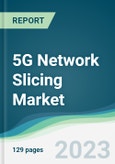GROWTH DRIVERS:
Increasing application across industry verticals
Industries like automotive, utilities, media, and entertainment are highly influenced by 5G technology. However, the unique characteristics of each business in the 5G network necessitate different throughput, latency, and reliability requirements for each sector. A crucial piece of technology called network slicing enables the creation of numerous logical networks that are customized to the requirements of each industry on top of a single physical infrastructure.Consequently, various developments across various industries can be witnessed. For instance,
In Electric Power Sector:
Field tests on network slicing in a number of common services in Nanjing and Beijing have been finished by China Telecom, the State Grid Corporation of China (SGCC), and Huawei. These services include differential protection, 4K ultra-HD video for power transmission lines, intelligent distributed feeder automation, situational awareness of the power distribution network, and load management at the millisecond level. The largest network of its kind in China, the 5G+Smart Grid experimental network, has also been inaugurated in Qingdao.In Multimedia Field
Network slicing in 4K ultra-HD multimedia live transmissions were field tested by China Mobile, MIGU, China Media Group, and Huawei in Shanghai and Beijing.EMERGING OPPORTUNITIES IN THE GLOBAL 5G NETWORK SLICING MARKET
Healthcare
The rapid adoption of implantable and wearable sensors encourages a variety of healthcare services and uses, from telemedicine to real-time and critical care tracking. Given the sensitivity of its data and services, reliability is crucial in smart healthcare (s-health). The autonomous assessment of network traffic and the adaptation of network resources to specific needs, such as s-health reliability, are two advantages of network slicing for smart health.The network slicing concept is also used by FLIPER(a Framework for Fingerprint s-Health Apps Traffic and Providing Network Resource Slicing) to provide automation, customization, and on-demand resource distribution based on fingerprinting analysis. Hence, the growing adoption of smart healthcare with the benefits of network slicing has driven the market players to take up various business measures that would complement the market growth.
In 2020, The Yuan Rung Medical Hospital and CHT, and Ericsson collaborated in 2020 to develop a 4G/5G remote consultation solution. This approach was important because it provided healthcare consultations with the required flexibility. A remote medical consultancy service was made available by implementing network slices with low latency and high bandwidth. Extra support from remote medical consultants assisted in delivering timely, remote medical diagnoses and reduced the workload for hospital staff.
NFV
The 5G network slicing market is segmented by technology into SDN-Based and NFV. NFV deployment is expected to attain a major share during the forecasted period owing to growing investments and partnerships by the market players.- In February 2020, The 5G-Ready NFV Platform from VMware was chosen by communications service providers such as Millicom, Singtel, Telecom Italia, Telia Company, and TIM Brasil as the basis for their telco cloud strategy. Their solution is an NFV-based, software-defined, automated, and virtualized system.
- In September 2020, Telkomsel and Ericsson allied to use the NFVI core network to enable the launch of 5G in Indonesia. The NFV infrastructure (NFVI) core network technology from Ericsson was adopted for a "major core network upgrade.
GEOGRAPHICAL PRESENCE
The global 5G network slicing market consists of major countries undertaking various measures to secure their 5G network. Some major countries include the USA, Japan, South Korea, China, and Germany. The countries have undertaken various measures, complementing the overall market growth. For instance,- In November 2021, Telefonica and Cisco formed a partnership alliance in Spain to launch the Network Slicing 5G pilot. Cisco joined hands with a number of other businesses to demonstrate how network slicing in a 5G infrastructure is possible.
- In February 2022, in Germany, the demonstration of 5G End to End Network Slicing with Quality of Service's global availability was revealed by Deutsche Telekom and Ericsson. Local traffic breakout, SD-WAN, and 5G slicing together allow for flexible connectivity establishment and management. The initiative has been made for enterprise applications that require consistent, global connectivity with guaranteed Quality of Service.
- In January 2023, in Japan, by demonstrating a network slicing trial that supported service level agreements, Samsung and KDDI claimed a major radio access network (RAN) intelligent controller (RIC) milestone. (SLAs). The decision allows the carrier to start providing business customers with network-slicing services on a commercial basis over its 5G network.
MAJOR MARKET PLAYERS:
Some of the leading players in the market include Samsung, Ericsson, Cisco, and Nokia, among others. These companies have undertaken various business strategies such as product launches, investments, and partnerships to expand their product offerings. For instance,- In June 2022, Nokia and Proximus partnered to offer 5G network slicing innovation. The alliance used new radio software-defined networking and radio resource allocation technologies to improve the performance of 5G network slicing in active and demanding environments. Industry 4.0 use cases are supported by Nokia's 4G/5G slicing and Edge Slicing suite.
- In August 2022, By showcasing multiple network slices on a single device that supports consumer and business applications, Ericsson and Google brought the complete range of 5G benefits closer to consumers. In their most recent collaboration, the ecosystem partners showed that the Ericsson network infrastructure could support multiple slices on a single Android 13-powered device, supporting consumer and business (work profile) apps.
MARKET SEGMENTATION:
The global 5G network slicing market has been analyzed through the following segments:By Industry Vertical
- Healthcare
- Government
- Transportation
- Energy & Utilities
- Manufacturing
- Others
By Application
- eMBB
- mMTCs
- URLLCs
- Others
By Technology
- SDN-Based
- NFV
By Geography
- Americas
- United States
- Others
- Europe, the Middle East, and Africa
- Germany
- UK
- Others
- Asia Pacific
- China
- Japan
- South Korea
- Others
Table of Contents
Companies Mentioned
- Samsung
- NTT
- Ericsson
- Cisco Systems Inc.
- Nokia Corporation
- Mavenir
- ZTE Corporation
- Intel Corporation








